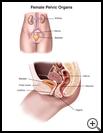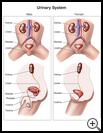
Marshall-Marchetti-Krantz Procedure
________________________________________________________________________
KEY POINTS
- The Marshall-Marchetti-Krantz procedure is a type of surgery done to help control leaking of urine during exercise, coughing, sneezing, laughing, or lifting.
- This surgery may be done if you have trouble holding urine.
- Ask your provider how long it will take to recover and how to take care of yourself at home.
- Make sure you know what symptoms or problems you should watch for and what to do if you have them.
________________________________________________________________________
What is a Marshall-Marchetti-Krantz procedure?
The Marshall-Marchetti-Krantz procedure is a type of surgery done to help a bladder control problem called stress incontinence. Stress incontinence is leaking of urine during exercise, coughing, sneezing, laughing, or lifting.
When is it used?
This surgery may be done if you have trouble holding urine. Your healthcare provider may recommend surgery when attempts to strengthen the muscles and tissues around the bladder with exercise or other treatments have not helped. After the surgery you should be able to urinate normally again. You may be able to go back to your usual activities without leaking urine. Bulging and feelings of pressure in the vagina will be relieved.
Instead of this procedure, other treatments to relieve symptoms may include:
- Lifestyle changes, such as changes in diet, weight loss, or avoiding strenuous activities
- Kegel exercises to strengthen the pelvic muscles
- A pessary, which is a silicone or plastic device prescribed by your healthcare provider. It’s inserted into the vagina to help support the uterus, bladder, and rectum.
- Shots of a collagen-like material through the vagina and under the bladder and urethra
- A mechanical insert that you can put inside the urethra to help hold urine
- Other surgical procedures to lift and tighten the tissue around the bladder
Surgery is usually done only after you have tried other treatments. Ask your healthcare provider about your choices for treatment and the risks.
How do I prepare for this procedure?
- Make plans for your care and recovery after you have the procedure. Find someone to give you a ride home after the procedure. Allow for time to rest and try to find other people to help with your day-to-day tasks while you recover.
- Follow your provider's instructions about not smoking before and after the procedure. Smokers may have more breathing problems during the procedure and heal more slowly. It is best to quit 6 to 8 weeks before surgery.
- You may or may not need to take your regular medicines the day of the procedure. Tell your healthcare provider about all medicines and supplements that you take. Some products may increase your risk of side effects. Ask your healthcare provider if you need to avoid taking any medicine or supplements before the procedure.
- Tell your healthcare provider if you have any food, medicine, or other allergies such as latex.
- Your provider will tell you when to stop eating and drinking before the procedure. This helps to keep you from vomiting during the procedure.
- Your provider may ask you to take an enema or medicine to clean out your bowel before surgery.
- Follow any other instructions your healthcare provider gives you.
- Ask any questions you have before the procedure. You should understand what your healthcare provider is going to do.
What happens during the procedure?
The surgery will be done at the hospital.
You will be given a general anesthetic. General anesthesia relaxes your muscles and you will be asleep.
Your healthcare provider will make a cut (incision) in your lower belly. Your provider will lift the tissue around the urethra (the tube that carries urine out of the body) with a stitch and fasten it to the bone in the front part of the pelvis and to tissue behind the abdominal wall.
Your provider may put a catheter (tube) into your bladder to drain urine. This tube may pass through the urethra, or the surgeon may insert it through a cut in the wall of your lower belly. Drains may be inserted through the incision to prevent infection by releasing any fluid or blood that collects in the area of the surgery. Your provider will then close the cut.
The surgeon may put gauze in your vagina. The gauze helps the bladder and urethra stay in place while the tissue starts healing. It also helps prevent bleeding. The gauze will be removed 2 to 3 days after the surgery.
What happens after the procedure?
You may stay in the hospital 2 to 6 days.
The drain in your incision will be removed when fluid is no longer leaking from your incision.
You may need to go home with a catheter in your bladder until the bladder is working normally again. Your healthcare provider will decide when the catheter can be removed during a follow-up visit.
Constipation is common after surgery because of some medicines and inactivity. Eating fruits and vegetables and drinking extra fluids may help you avoid constipation. If diet and extra fluids are not enough to avoid constipation, your provider may recommend a stool softener or a laxative. Check with your healthcare provider if constipation keeps being a problem.
You may have some bloody or pink drainage from your vagina for a few weeks.
Ask your healthcare provider:
- How long it will take to recover
- If there are activities you should avoid, including how much you can lift, and when you can return to your normal activities
- How to take care of yourself at home
- What symptoms or problems you should watch for and what to do if you have them
Make sure you know when you should come back for a checkup. Keep all appointments for provider visits or tests.
What are the risks of this procedure?
Every procedure or treatment has risks. Some possible risks of this procedure include:
- You may have problems with anesthesia.
- You may have infection, bleeding, or blood clots.
- The bladder, ureters (the tubes from the kidneys to the bladder), or urethra may be damaged. If damage occurs and your provider is aware of it, he or she will try to repair it during the operation.
- You may keep leaking urine.
- You may have problems urinating.
- You may have a frequent feeling that you need to urinate.
- You may develop painful inflammation in the area over your pubic bone.
Ask your healthcare provider how these risks apply to you. Be sure to discuss any other questions or concerns that you may have.


